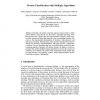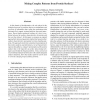BIBE
2003
IEEE
14 years 5 months ago
2003
IEEE
The tertiary (3D) structure of a protein contains the essential information for understanding the biological function of the protein at the molecular and cellular levels. Traditio...
FPL
2004
Springer
14 years 5 months ago
2004
Springer
The proteins in living organisms perform almost every significant function that governs life. A protein's functionality depends upon its physical structure, which depends on i...
PCI
2005
Springer
14 years 6 months ago
2005
Springer
Nowadays, the number of protein sequences being stored in central protein databases from labs all over the world is constantly increasing. From these proteins only a fraction has b...
CP
2005
Springer
14 years 6 months ago
2005
Springer
In this paper we show how Constraint Programming (CP) techniques can improve the efficiency and applicability of grid-based algorithms for optimising surface contact between comple...
COMPLIFE
2005
Springer
14 years 6 months ago
2005
Springer
Abstract. Most software tools in homology recognition on proteins answer only a few specific questions, often leaving not much room for the interpretation of the results. We devel...
BERTINORO
2005
Springer
14 years 6 months ago
2005
Springer
Fractal proteins are an evolvable method of mapping genotype to phenotype through a developmental process, where genes are expressed into proteins comprised of subsets of the Mande...
DEXAW
2005
IEEE
14 years 6 months ago
2005
IEEE
In the domain of bioinformatics, the role played in the biological process by proteins, that act as transmitters and receivers of information thus ruling the mechanisms that deter...
DASFAA
2005
IEEE
14 years 6 months ago
2005
IEEE
A novel approach for similarity search on the protein structure databases is proposed. PADS (Protein Alignment by Directional shape Signatures) incorporates the three dimensional ...
CSB
2005
IEEE
14 years 6 months ago
2005
IEEE
Protein Data Integration approaches at the moment considers data sources as data repositories, but not as applications; which in turn may embody complex interactions with other da...
CIBCB
2005
IEEE
14 years 6 months ago
2005
IEEE
- Establishing structure-function relationships on the proteomic scale is a unique challenge faced by bioinformatics and molecular biosciences. Large protein families represent nat...





